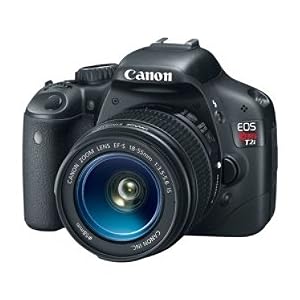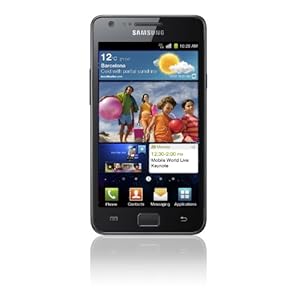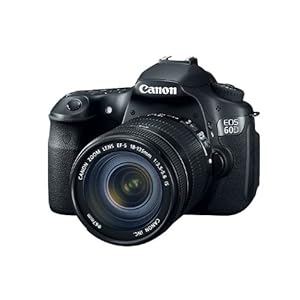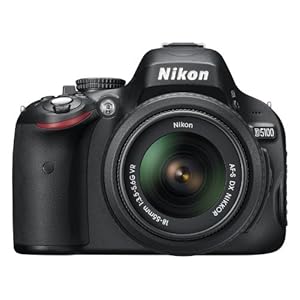
Canon EOS Rebel T2i 18 MP CMOS APS-C Digital SLR Camera with 3.0-Inch LCD and EF-S 18-55mm f/3.5-5.6 IS Lens
by
Canon
List Price: $899.95
Price:See price in cart(Why don't we show the price?)
Canon EOS Rebel T2i: Review by dpreview.com

The EOS 550D combines high-end features adopted from the 7D, with the low-cost, user-friendly ergonomics of previous entry-level models like the EOS 500D. On paper its the most compelling Rebel-series DSLR to date, so can it span the bridge between first-time DSLR buyers and more experienced users? Read our full test to find out.
Product Description
Style: With 18-55mm Lens
From the Manufacturer
The new flagship of the EOS Rebel line, Canon EOS Rebel T2i brings professional EOS features into an easy to use, lightweight digital SLR that's a joy to use. Featuring a class-leading 18.0-megapixel CMOS image sensor and increased light sensitivity for low light photography, the EOS Rebel T2i also has an advanced HD Movie mode for gorgeous Full HD movies. Able to capture up to 3.7 frames per second, it's ready to go the minute it's picked up. Advanced Live View, a new wide-area screen, plus features like Canon's brilliant Auto Lighting Optimizer and Highlight Tone features ensure brilliant photos and movies, easily. With some of the most advanced features of any digital SLR, it's simply the best Rebel Canon has ever created.

EOS Rebel T2i Highlights
18.0-megapixel CMOS (APS-C) sensor and DIGIC 4 Image Processor
The EOS Rebel T2i has an 18.0-megapixel CMOS sensor that captures images with exceptional clarity and tonal range and offers more than enough resolution for big enlargements or crops. This first-class sensor features many of the same new technologies as used by professional Canon cameras to maximize each pixel's light-gathering efficiency. Its APS-C size sensor creates an effective 1.6x field of view (compared to 35mm format).

DIGIC 4 Image Processor
The Canon DIGIC 4 Image Processor dramatically speeds up the entire EOS Rebel T2i's camera operations for intuitive operation and offers improvements in both fine detail and natural color reproduction. It works in concert with the EOS Rebel T2i's CMOS Image Sensor to achieve phenomenal levels of performance in nearly any situation.

Capture stunning shots in low light.
ISO 100-6400 (expandable to 12800) for shooting from bright to dim light
The EOS Rebel T2i features an expanded ISO range that makes shooting possible in situations previously unthinkable without flash. With an ISO rating up to 6400 (expandable to ISO 12800), along with the DIGIC 4 Image Processor's improved noise-reduction technology, creative possibilities abound. Combine the EOS Rebel T2i with one of Canon's EF or EF-S lenses with Optical Image Stabilizer and the shooting possibilities for both movies and stills expand even further.
Improved EOS Movie mode with manual exposure control
Designed for the evolving, tech-savvy user, the EOS Rebel T2i features HD Video capture technologies--manual exposure control for more creative control, for example--borrowed directly from professional Canon SLRs to capture stellar video with all the benefits of shooting with an SLR. By shooting video with the EOS Rebel T2i, photographers as well as filmmakers can take advantage of the creative features native to SLR cameras. Along with its manual controls, the EOS Rebel T2i allows for full use of Canon EF and EF-S lenses, including Macro and Fisheye, providing a plethora of shooting options once reserved only for still photography. The resulting HD video is a standout in its beautiful depth-of-field characteristics and remarkable capture capability under poor lighting conditions. In a first for EOS cameras, a Movie Crop function is included: An SD-quality movie (640 x 480) can be cropped to the equivalent of about 7x magnification of regular shooting.

Video can be captured at a number of resolutions and frame rates for numerous applications. It can capture 1920 x 1080 Full HD video at frame rates of 24 (23.976), 25 or 30 (29.97) frames per second, for up to 4GB per clip. Movies are saved as MOV files and can be viewed in Full HD through the EOS Rebel T2i's HDMI output. Other recording sizes include HD at 1280 x 720 (50/60 (59.94) fps) or SD/VGA at 640 x 480 (50/60 (59.94) fps). The EOS Rebel T2i has a built-in microphone for simple mono recording and stereo sound can be recorded through a self-powered external microphone.
Wide 3.0-inch (3:2 aspect ratio) Clear View LCD monitor
The EOS Rebel T2i has a high-resolution 3.0-inch Clear View LCD monitor that features 1.04 million dots/VGA for spectacular detail. It also has the same aspect ratio (3:2) as the camera's sensor, making for clear and easy Live View composition. An anti-reflective and water-repellant coating provides a clearer and more smudge-resistant surface and screen brightness can be adjusted in 7 steps in accordance with ambient light.

New Quick Control Screen button
The EOS Rebel T2i's refined button layout includes a dedicated button that directs the camera immediately to the Quick Control screen, where it's simple to navigate among any number of settings, including ISO, Exposure and Flash Exposure compensation, drive mode, white balance, image quality and much, much more.


Improved layout with dedicated Live View/Movie shooting button
Without the need to navigate through a bunch of menus, the EOS Rebel T2i transitions effortlessly between still and movie mode. By pressing the Live View/Movie button, a situation that had required menu access with other cameras, still images can change to a movie shoot and vice versa. It's literally as simple as the press of a button.
3.7fps continuous shooting up to approximately 34 JPEGs or approximately 6 RAW
The EOS Rebel T2i can shoot up to 3.7 frames per second (fps) for up to approximately 6 consecutive RAW files or approximately 34 full-resolution JPEGs. Shooting at speeds of up to 1/4000 sec., the EOS Rebel T2i can capture even rapidly-unfolding scenes with ease.
Compatible with the full line of Canon EF and EF-S lenses

EF Lenses
The EOS Rebel T2i is compatible with all Canon lenses in the EF lineup, including compact and lightweight EF-S lenses, ranging from ultra-wide angle to super telephoto lenses. Canon lenses employ advanced optical expertise and micron-precision engineering to deliver outstanding performance and deliver beautiful results. Special technologies like the Canon Image Stabilizer technology in select lenses helps to minimize the effect of camera shake, effectively adding up to four stops of light. With a dizzying array of lenses perfect for travel, sports, still life and everything in between, photographers can truly maximize the quality and performance of their EOS Rebel T2i with superlative Canon optics.
ZoomBrowser EX (Version 6.5.0) for Windows and ImageBrowser (Version 6.5.0) for Mac OS X are the easy, user-friendly options for viewing and editing of JPEG and even RAW image files. Both allow viewing of numerous types of images including finished TIFF and BMP files. Both also have a variety of search options for finding images, allow re-naming of single images or batches of files, and offer a variety of options for printing without using a separate image-editing program.

What's in the Box
- EOS Rebel T2i Body
- EF-S 18-55mm f/3.5-5.6 IS Lens
- Eyecup Ef (Not shown)
- Wide Strap EW-100DBIII
- USB Interface Cable IFC-130U
- AV Cable AVC-DC400ST
- Battery Pack LP-E8
- Battery Charger LC-E8
- EOS Digital Solution Disk and Instruction Manuals
- "Great Photography is Easy" Booklet and "Do More with Macro" Booklet (not shown)
Most Helpful Customer Reviews
PERFECT!,
By G. Argov -
This review is from: Canon EOS Rebel T2i 18 MP CMOS APS-C Digital SLR Camera with 3.0-Inch LCD and EF-S 18-55mm f/3.5-5.6 IS Lens (Electronics)
Whether you're new to the world of DSLRs, or are a seasoned photographer who wants to try your luck at video, the Canon Rebel T2i is perfect. I've had nothing but great experiences with it so far, and highly recommend to everyone.
Other than the T2i, I own (and primarily shoot with) the Rebel XS (1000D), and also have extensive experience with the Canon 50D. While my XS still serves me very well, I wanted to get an SLR with video capabilities since the release of the T1i. After finally saving up enough for the T1i, I really lucked out that Canon announced the T2i, which has even better features! I am lucky enough to finally have it, and want to share my experiences, and how they compare to my expectations
==================
OVERALL IMPRESSIONS
The camera is very small and light. It is not weather-sealed or as durable as some of the more expensive SLRs, but it doesn't "feel cheap" in my opinion. It features a 3-inch LCD (compared to the Rebel XS's 2.5 inch screen), which also has a very high resolution. It looks lovely! Auto-focus is fast, and I've been very pleased with the quality of the pictures and videos I've taken so far.
==================
PROS
IMAGE QUALITY: I feared that cramming so many megapixels onto this sensor, there would be a lot of image 'noise' (the megapixel myth). This thankfully hasn't been an issue, and I've been very pleased with the pictures taken with this camera! Aside from White Balance issues (see below, Cons), image quality is pretty good!
VIDEO: Some people have disparagingly said that Video on DSLRs is just a gimmick. I disagree. Based on sample clips I'd seen on YouTube, I was excited about getting an HDSLR, and while videos are sometimes shaky if you don't have very steady hands, a tripod eliminates those concerns. Audio quality on the T1i was criticized by many, but the T2i has a microphone input jack, which allows you to connect a mic. I don't yet own one so can't comment on that feature, but will update this review if and when I save enough to try this feature out. Additionally, this offers improved recording options, including higher fps (frames per second) than the T1i, which technically offered "true HD" recording of 1080, but only at a choppy 20 fps.
LOW-LIGHT PERFORMANCE: I am much more impressed than I expected. My Rebel XS could go up to ISO 1600, but would perform pretty poorly there. This not only can go up to a significantly higher ISO level, but performs much better. Less image noise means you have to waste less time editing your pics, and many more keepers!
SDXC SUPPORT: Only own SDHC cards up until now, but it's great to know that this supports the next generation of flash storage, which means you'll in the future be able to hold many more pictures than currently available.
CONS
NOT A FULL-FRAME SLR: This is not a full-frame SLR like the Canon 5D Mark II, and the APS-C sized sensor results in a crop factor (1.6x), and doesn't necessarily provide the same image quality as the larger, full-frame sensor does. Still, at less than half the cost of the Mark II, I think this is a trade-off that's well worth it for most users.
Crop factor means that this camera, like other Canon DSLRs that have the APS-C size image sensor, will not be true to the lens's designation. A 50mm lens will produce an image more in line with 50mm x 1.6, or 80mm on a full-frame. This not only makes a difference for those who want to do landscape photography (which usually benefits from wide-angle views), but for those with unsteady hands. The general logic is that to ensure a steady shot, you need to shoot at the reciprocal of your focal length. So for a 50mm focal length, you should be shooting at a speed faster than 1/50 second for a steady shot. Keeping the crop factor in mind, you really should be shooting at a speed faster than 1/80 a second.
Crop factors are common for most digital SLRs, as full-frame sensors jack up the cost of production, which are then passed on to the consumer in the form of very expensive cameras. So it's not so much a shortcoming of the Rebel T2i, but just a note to keep in the back of your mind.
DIFFERENT BATTERY: This is more of a hassle for those who owned spare batteries than for those whose first SLR would be the T2i, but Canon changed the battery. Again, not such a big deal, but might be a hassle for some who find out that their old batteries can't be used on this model.
WHITE BALANCE: I found that the 'Auto' White-Balance setting was wildly inaccurate on my Rebel XS (often giving indoor shots a yellow tint unless I changed the WB to the 'Incandescent Light' mode), and I feel that the WB settings on this model still aren't as accurate as they should be. If you want truly accurate WB, you can use a gray card, or an alternative would be to simply try digitally editing the photos on your computer after shooting.
NO ARTICULATING SCREEN: No articulating screen, but this is a rare feature in DSLR's in general, so it's not a shortcoming of the T2i. Since most of your shots will probably be composed using the viewfinder, not a big deal, although it would have been convenient! If you absolutely must have an articulating screen on an HDSLR, look into the Nikon D5000.
===================
A NOTE ABOUT THE KIT LENS
The lens that comes with this is the standard 18-55 f/3.5-5.6 that comes with the other Rebels. It's a very good all-around lens, but you more likely than not will want to at some point upgrade your lens for either (a) better image quality, or (b) better performance in low-light conditions.
This lens is very good, but for pros or those who pay incredibly close attention to detail, the optical quality of Canon's higher-end lenses is superior than to the kit lens. For most users, I don't think image quality will be a huge issue.
More likely, the aperture size will be the reason people want to upgrade their lens over time. A lens with a wider aperture allows more light to reach the sensor in less time than a lens with a narrower aperture. That means you can employ a faster shutter speed, which allows you to snap the shot faster, reducing the likelihood of a blurry picture. Outdoors on a sunny day, this aperture range of this lens won't be a limiting factor; inside a poorly-lit gym, however, you'll notice some blurry shots (see below for a recommended alternative for low-light shooting).
Still, this is a pretty good all-around lens that can result in some great shots!
===================
RECOMMENDED ACCESSORIES
1. An external flash: This will come in very handy. With the built-in flash, your photos often come out harshly lit. Bouncing an external flash off the wall makes a huge difference in image quality. I personally use the Speedlite 580EX II, but there are cheaper alternatives that are very good. Some higher-end cameras (i.e. Canon 5D Mark II) don't even have a built-in flash, which goes to show something about how high-level photographers view the lighting provided by internal flashes.
2. 50mm f/1.8 II lens - At around one hundred dollars, this lens is relatively cheap when compared to others on the market. Despite its low price, it offers great image quality. While it lacks IS (image stabilization) like some other Canon lenses (including the kit lens), with a wide aperture of f/1.8, enough light usually comes in to ensure a fast shutter speed, which in turn minimizes camera shake. Keep in mind that as a 'prime' lens, your feet will have to do the zooming in and out. This is not as convenient as an everyday walk-around lens like the 18-55 kit lens which gives a good zoom range, but is a great lens for portraits. Also would ideally be a good option for poorly-lit places where the aperture of the kit-lens isn't wide enough to ensure a steady shot.
CONCLUSIONS
From my list of 4 pros and 4 cons, you might wonder why I'm giving this product 5 stars?... It's because considering the great performance - and low price - of the T2i, the 'cons' I list really aren't that big of a deal. Just because some cameras offer the aforementioned features the T2i lacks, it doesn't mean the T2i isn't a solid performer. On the contrary, I have been completely satisfied with this camera's image and video quality, performance, features, AND PRICE, and would recommend the T2i to anyone looking for an affordable way to capture memories!
------------------
EDIT 11/27/10
I just wanted to update this review to say that after shooting with the T2i for nearly half a year, I'm still as impressed by this camera as when I first got it. I have a few comments to expand on my initial review:
VIDEO I have been using the video mode a lot more than I initially expected. While it doesn't offer continuous auto-focus and therefore might not replace a camcorder, once you get the hang of manually focusing this is not a big problem. I many times have found myself in situations where photos couldn't capture the moment as well as a video could, and the ability to record clips has been very convenient.
A note on the video mode, however...while it's automatic exposure is fine for most situations, if you find your videos are grainy, it's best to manually control the exposure. I've seen that sometimes even in good lighting, the camera will keep the aperture small (to have a less shallow depth of field) and boost the ISO. You can get around that by manually adjusting exposure settings, but again, the automatic exposures are usually fine.
As for audio with videos, I personally still have not purchased an external microphone, but for those who are serious about movie production Amazon sells a highly popular 'Rode VideoMic' for a... Read more ›





























